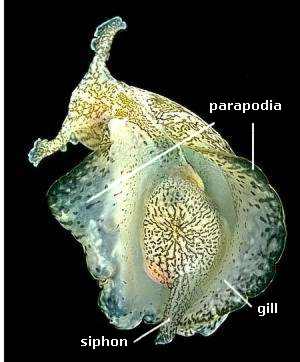Behavioral Neuroscience, lecture on Aplysia Classical Conditioning of Siphon Withdrawal
Siphon Withdrawal
X. Conditioning & Memory
A. Classical/Pavlovian Conditioning
1. salient stimulus (US = unconditioned stimulus)
elicits behavior (UR = unconditioned response)
a. bring food (US) to dog Þ salivation (UR)
b. shock (US) to aplysia tail Þ gill retraction (UR)
2. pairing with a non-salient stimulus (CS = conditioned stimulus)
results in associative learning
a. conditioning is more complex than sensitization
i. association of 2 stimuli
b. repeatedly ring a bell (CS) just before bringing food US
i. bell (CS) alone will elicit salivation (CR = conditioned response)
c. touch siphon or mantle shelf with tail shock
i. US alone = shock causes strong gill retraction
ii. CS alone = touching siphon causes weak gill retraction
iii. training = CS + US (shock + touching siphon)
iv. following pairing:
CS alone = touching siphon causes strong gill retraction
3. Timing is critical
a. CS must precede the US
i. within an interval of 0.5 s
b. CS precedes but slightly overlaps US = delay conditioning
c. CS first, time gap, then US = trace conditioning
4. US activates facilitating interneurons
a. with delay training the modulatory interneurons
are engaged immediately after the CS
b. activity dependent - facilitation during CS + US pairing Þ
Þ facilitation with CS alone
i. presynaptic mechanisms - synergy at Adenylate Cyclase (AC)
(1) activity in CS Glu neuron causes Ca++ influx
(2) Ca++ + calmodulin binds to AC
(3) potentiates 5-HT4,6,7-like production of cAMP
(a) Tail shock (US) stimlates 5-HT interneurons
that impinge on CS siphon/mantle neurons
(4) stimulation of siphon/mantle now reactivate
5-HT modulation on siphon/mantle sensory output
(a) AC = coincidence detector
(i) responds to both CS and US
ii. postsynaptic - retrograde signal
(1) during sensitization Glu binds AMPA-R on motor neuron
(a) not enough depolarization
to remove Mg++ from NMDA-R
(2) paired CS + US Ý depolarization Þ
Þ expels Mg++ Þ Ca++ influx
(3) train of action potenitals in the motor neuron
(4) Ca++ Þ Ý retrograde signal
(a) Aplysia have synthetic/degradative pathways
for NO (nitric oxide)
(b) Ca++ Þ Ý NOS (NO synthase)
(c) NOS coverts Arg Þ Cit: NO given off
(d) NO is a gas \ a retrograde signaler
(e) NO binds heme group of GC activates cGMP
(i) cGMP facilitates both transmitter release
and learning
(ii) is NO the retrograde signal?
B. Operant-Reward Conditioning
1. similar to classical conditioning except
a. a behavior replaces the CS
i. e.g. dog steps on pedal to get food
(1) both pedal or bell would stimulate salivation
(a) also called instrumental conditioning
2. Aplysia operant behavior is biting
a. esophageal nerve activated when random biting
and swallowing seaweed are successful
i.reward signal = dopamine (DA)
(1) DA is also the salient neurotransmitter in the
nucleus accumbens vertebrate reward system
b. no esophageal nerve signal on "empty" bite
3. Virtual reward = stimulation of esophageal nerve
a. operant training = virtural reward paired with random biting
4. CR = increased spontaneous biting
C. Long-Term Memory
1. Übung macht den Meister (Practice makes perfect)
a. repeated experience consolidates memory
i. converting short-term into longer term memory
ii. independent but overlapping processes
2. First: Sensitization, via 5-HT, enhances release of transmitter (Glu)
a. through 5-HT4,6,7 receptors activtate cAMP + PKA
3. Then: Consolidation involves:
a. gene expression
b. new protein synthesis
c. growth or pruning of synaptic connections
4. 5-HT4,6,7 Þ Ý PKA Þ Ý MAP Kinase
a. PKA + MAP K Þ nucleus
b. PKA phosphoylates CREB1 (transcription factor)
i. MAP K removes CREB2 inhibition from CREB1
c. CREB1 binds to CRE (cAMP response element)
i. CRE in promotor or enhancer of cAMP inducible genes
d. CREB/CRE stimulates ubiquitin carboxythermal hydrolyase gene
e. ubiquitin hydrolyase cleaves the inhibitory regulatory subunit of PKA
i. \ persisent PKA activity
ii. \ persistent sensitization
f. CREB/CRE also stimulates another important transcription factor
via the C/EBP gene
i. C/EBP binds to the CAAT box at the promotor/gene junction
of many genes associated with growth
(1) transcription of growth-related proteins - EF1a
ii. new synapses ar formed
D. \ LTS and Conditioning in Aplysia
are reinforced / consolidated by
1. presynaptic synergy at AC
a. greater effect of 5-HT
i. more Glu release
2. postsynaptic recruitment of NMDA-R current
and retrograde messenger release
a. more Ca++ influx
3. retrograde facilitation of presynaptic release
a. more Glu release
4. repeated 5-HT (interval important) stimulates gene expression
a. persistent PKA
i. greater effect of 5-HT
(1) more Glu release
b. new growth proteins, like elongation factor 1a = EF1a
5. growth proteins Þ new synapses
a. more sites for Glu release
